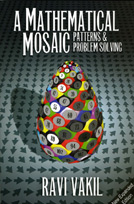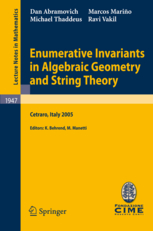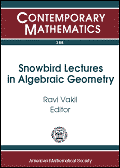Any comments, corrections or suggestions would be greatly appreciated. I haven't posted TeX files of articles with complicated figures.
1. "On Conway's recursive sequence", with T. Kubo, Discrete Math. 152 (1-3) (1996) pp. 225-252.
2. "Enumerative geometry of curves via degeneration methods". Ph.D. Thesis, Harvard University, 1997, under the supervision of Joe Harris.
3. "On the Steenrod length of real projective spaces:
finding longest chains in certain directed graphs",
in the Gould Anniversary Volume of Discrete Math. 204 (1-3) (1999) pp. 415-425.
4. "The enumerative geometry of rational and elliptic curves in
projective space", J. Reine Angew. Math.
(Crelle's Journal) 529 (2000), 101--153.
![]()
![]()
![]()
5. "Recursions for characteristic numbers of genus one plane curves",
Arkiv for Matematik, 39 (2001), no. 1, 157--180.
![]()
![]()
![]()
6. "Characteristic numbers
of quartic plane curves", Can. J. Math. 51 (1999), no. 5, 1089--1120.
![]()
![]()
This article
won the G.
de B. Robinson Award for best article in the Can. J. Math.
in 1998 and 1999.
7.
"Genus 0 and 1 Hurwitz numbers:
Recursions, formulas, and graph-theoretic interpretations",
Trans. Amer. Math. Soc., 353 (2001), 4025--4038.
![]()
![]()
![]()
8.
"Counting curves on rational surfaces",
manuscripta math. 102 (2000), 53--84.
![]()
![]()
![]()
Update 2011: For an interesting follow-up, which can deal with the case
of the "degree 3 Fano = cubic surface" more directly, and may lead to
the degree 2 case, see Shoval and Shustin's paper 1106.155 on the arXiv.
9. "Twelve points on the projective line, branched covers, and
rational elliptic fibrations", Math. Ann. 320 (2001) no. 1, 33--54.
![]()
![]()
![]()
10.
"The Gromov-Witten potential of a point, Hurwitz numbers, and
Hodge integrals", with I. P. Goulden and D. M. Jackson,
Proc. London Math. Soc. (3) 83 (2001), no. 3, 563--581.
![]()
![]()
![]()
11.
"Hodge integrals and Hurwitz numbers via virtual localization",
with T. Graber, Compositio Math. 135 (1) (January 2003), 25--36.
![]()
![]()
![]()
Correction: Maryam Mirzakhani points out that the formula for Hurwitz numbers with two parts, just after
the statement of the main theorem, should not have a factor of d^d.
12.
"On the tautological ring of  ", with T. Graber,
in (refereed) Proceedings of the
Gokova Geometry-Topology conference 2000, Akbulut, Onder and Stern eds., International Press, 2001.
", with T. Graber,
in (refereed) Proceedings of the
Gokova Geometry-Topology conference 2000, Akbulut, Onder and Stern eds., International Press, 2001.
![]()
![]()
![]()
13. "A tool for stable reduction of curves on surfaces", in "Advances
in Algebraic Geometry Motivated by Mathematical Physics", E. Previato
ed., Contemp. Math. 276 (2001), 145-154 (refereed).
![]()
![]()
![]()
14. "The moduli space of curves and its tautological ring",
Notices of the Amer. Math. Soc. (feature article),
vol. 50, no. 6, June/July 2003, p. 647-658.
![]()
![]()
![]() ,
article
,
article
15. "A geometric Littlewood-Richardson rule" (with an appendix
joint with A. Knutson),
Annals of Math. 164 (2006), 371-422.
16. "Relative virtual localization, and vanishing of tautological classes on moduli spaces of curves",
with T. Graber, Duke Math. J., vol. 30, no. 1, 2005, 1--37.
![]()
![]()
![]()
17. "Schubert induction", Annals of Math. 164 (2006), 489-512.
18. "Towards the geometry of double Hurwitz numbers",
with I. P. Goulden and D. M. Jackson,
Advances in Mathematics, (special issue in honour of Michael Artin)
198 (2005), 43-92.
![]()
![]()
![]()
19. "The affine stratification number and the moduli space of curves",
with M. Roth, (refereed) Proceedings of "Workshop on algebraic structures and
moduli spaces", CRM Proceedings and Lecture Notes, Universite de Montreal,
Volume 38, 2004, 213-227.
![]()
![]()
![]() ,
addenda and corrigenda
,
addenda and corrigenda
20. "Murphy's Law in algebraic geometry: Badly-behaved
deformation spaces", Invent. Math. 164 (2006), 569--590.
![]()
![]()
![]() ,
arXiv version includes arguments later excised.
,
arXiv version includes arguments later excised.
20a. "Murphy's Law for the Hilbert scheme (and the Chow variety, and
moduli spaces of surfaces of general type, and nodal and cuspidal
plane curves, and ...)", Oberwolfach Reports Vol. 1 No. 3, 2004,
p. 1676-1678.
electronic
publication version (click on "report" and go to page 22)
21. "Intersections of Schubert varieties and other
permutation array schemes",
with S. Billey, in "Algorithms in Algebraic Geometry",
IMA Volume 146, p. 21-54, 2008.
![]()
![]()
![]() ,
maple code available on Sara Billey's webpage.
,
maple code available on Sara Billey's webpage.
22.
"The equations for the moduli space of n points on the line",
with B. Howard, J. Millson, and A. Snowden, Duke Math. J. 146 no. 2 (2009), 175-226.
The accepted version
(Mar. 7 '08):
![]() .
Based on older preprints on the arXiv, 0505096 and 0607372.
.
Based on older preprints on the arXiv, 0505096 and 0607372.
The code used in the paper is available here. ![]()
23. "The moduli space of curves and Gromov-Witten theory",
in "Enumerative invariants in algebraic geometry and string theory"
(Behrend and Manetti eds.), Lecture Notes in Mathematics 1947, Springer,
Berlin, 2008.
![]()
![]()
24. "A short proof of the λg-conjecture without Gromov-Witten theory: Hurwitz theory and
the moduli of curves",
with I.P. Goulden
and D.M. Jackson,
J. Reine Angew. Math.
(Crelle's Journal), 637 (2009), 175-191.
Jul 15 '08 version
![]()
25. "A natural smooth compactification of the space of elliptic
curves in projective space", with A. Zinger, Electronic
Research Announcements of the Amer. Math. Soc. 13 (2007) 53--59.
25a. "A natural smooth compactification of the space of elliptic
curves in projective space via blowing up the space of stable maps", with A. Zinger, Oberwolfach Reports, 27/2006, 1643-1645.
![]()
![]()
![]()
26. "The moduli space of curves, double Hurwitz numbers, and Faber's intersection number conjecture", with I.P. Goulden
and D.M. Jackson, Annals of Combinatorics, 15 no. 3 (2011), 381-436.
![]()
27. "Geometric positivity in the cohomology of homogeneous spaces and
generalized Schubert calculus", with I. Coskun, in "Algebraic Geometry
--- Seattle 2005" Part 1, 77--124, Proc. Sympos. Pure Math., 80, Amer.
Math. Soc., Providence, RI, 2009.
![]()
28. "A desingularization of the main component of the moduli space of
genus-one stable maps to projective space", with A. Zinger,
Geom. Topol. 12 (2008), no. 1, 1-95.
![]()
29. "Absolute Galois acts faithfully on the components of the moduli
space of surfaces: A Belyi-type theorem in higher dimension", with R. Easton,
Int. Math. Res. Notices IMRN 2007, no. 20, Art. ID rnm080, 10 pp.
![]()
![]()
![]() ,
earlier
,
earlier ![]()
30. "A new description of the outer automorphism of S6,
and the invariants of six points in projective space", with B. Howard,
J. Millson, and A. Snowden, J. Comb. Theory Ser. A, 115 (2008), no. 7, 1296-1303.
![]() ,
,

Erratum: in section 2.2, the quotient of 6 points in 3-space should be described as the Segre cubic, not the Igusa quartic. (We thank Daniel Huybrechts for catching this.)
This note relates to the baby toy on the right. I discovered later
that this toy, made by Hands on Toys (who make other cool things), was created
by a sculptor and mathematician, Dick Esterle. At some point I hope
to write more about this. You can order the toy on the web:
google "Nobbly Wobbly".
31. "Algebraic structures on the topology of moduli spaces of curves
and maps", with Y.P. Lee, in Surveys in Differential Geometry
Vol. XIV: "Geometry of Riemann surfaces and their moduli spaces"
in honor of the 40th anniversary of Deligne and Mumford's paper,
197-216, Sur. Differ. Geom. 14, Int. Press, Somerville, MA, 2009.
![]()
32. "The geometry of eight points in projective space: Representation theory, Lie theory, dualities", with B. Howard, J. Millson, and A. Snowden, Proc. Lond. Math. Soc. (3) 105 (2012), no. 6, 1215-1244.
33. "Universal covering spaces and fundamental groups in algebraic
geometry as schemes", with K. Wickelgren, J. Theor.
Nombres Bordeaux 23 (2011), no. 2, 489-526.
Adrian Langer kindly told us
about an earlier description of nonexistence of group structure on
etale covers of group schemes; Maruyama has a great example, which is
Remark 4 in Miyanishi's paper "On the algebraic fundamental group of
an algebraic group" (J. Math. Kyoto Universit, 12 (1972) 351-367).
See "Covering spaces of algebraic groups" by Andy Magid
(Am. Math. Monthly 83 (1976) 614-621) for more.
![]()
34. "The relations among invariants of points on the
projective line", with B. Howard, J. Millson, and A. Snowden,
C.R. Math. Acad. Sci. Paris 347 (2009), no. 19-20, 1177-1182. This is an announcement of the results of papers #35 and #32.
![]()
35. "The ideal of relations for the ring of invariants of n
points on the line", with B. Howard, J. Millson, and A. Snowden, J. Eur.
Math. Soc., 14 (2012) no. 1, 1-60. This is the main paper in the series we four
have written, and resolves the structure hinted at in #22. Code is
available here.
![]()
36. "The ideal of relations for the ring of invariants of n points on the line: integrality results", with B. Howard, J. Millson, and A. Snowden, Comm. Algebra 40 (2012), no. 10, 3884-3902.
37. "Solving Schubert Problems with Littlewood-Richardson Homotopies",
with F. Sottile and J. Verschelde, in "Proceedings of the 2010 International Symposium on Symbolic and Algebraic Computation", Stephen W. Watt ed., ACM 2010, p. 179-186.
![]()
38. "Formal pseudodifferential operators and Witten's r-spin numbers", with K. Liu and H. Xu,
J. Reine Angew. Math.
(Crelle's Journal), to appear.
![]()
39. "Mnev-Sturmfels universality for schemes", with S. H. Lee, in "A celebration of algebraic geometry", 457-468, Clay Math. Proc., 18, Amer. Math. Soc., Providence, RI, 2013, 457-468.
![]()
40. "Discriminants in the Grothendieck ring", with M. M. Wood, Duke Math. J. 164 (2015), no. 6, 1139-1185.
![]()
41. "The Chow ring of the moduli space of curves of genus six", with
N. Penev, Algebr. Geom. 2 (2015), no. 1, 123--136.
![]()
42. "Motivic Hilbert zeta functions of curves are rational", with D. Bejleri and D. Ranganathan, Journal of the Institute of Mathematics of Jussieu, 2020;19(3):947--964. doi:10.1017/S1474748018000269, arXiv:1710.04198.
43. "Numerical Schubert Calculus via the Littlewood-Richardson Homotopy Algorithm", with A. Leykin, A. Martin del Campo, F. Sottile, and J. Verschelde, Mathematics of Computation, Volume 90, Number 329, May 2021, Pages 1407--1433, arXiv:1802.00984.
44. "Numerical Schubert Calculus in Macaulay2", with A. Leykin, A. Martin del Campo, F. Sottile, and J. Verschelde, submitted, arXiv:2105.04494.
45.
"Low-degree Hurwitz stacks in the Grothendieck ring", with A. Landesman and M. M. Wood, Compositio Math., 2024; 160(8), arXiv:2203.01840.
article
46. "Tschirnhausen bundles of covers of the projective line", with S. Vemulapalli.
![]()
47. "Complex Bott periodicity in algebraic geometry", with H. Larson.
![]()
Here are some. I've not bothered linking to many others (in my column in the Mathematical Intelligencer with Michael Kleber, or in Mathematical Mayhem, for example).
1. "πp, the value of π in lp", with J. Keller, Amer. Math. Monthly, 116 (Dec. 2009), no. 10, 931-935. An interesting article we learned of after this article was published: p-arclength of the q-circle, by Lindqvist and Peetre, in the Mathematics Student in 2003.
2.
"The Mathematics of Doodling", Amer. Math. Monthly, February 2011.
This article has won the Lester R. Ford Award in 2012 and the Chauvenet Prize in 2014.
(Vi Hart has another terrific take on doodling and mathematics.)
article
3. MathOverflow, with A. Geraschenko and S. Morrison, Notices of the Amer. Math. Soc., June/July 2010, p. 701.
4. "Algebraic geometry and the ongoing unification of mathematics", Eur. Math. Soc. Newsl. No. 89 (2013), 24-30.
5. "REUs with limited faculty involvement, "underrepresented" subjects in the undergraduate curriculum, and the culture of mathematics", with Y. Ribinstein, World Scientific Publ., 2016, 53-72.
6. "The interpolation problem: When can you pass a curve of a given type through N random points in space?", with E. Larson and I. Vogt, Bull. Amer. Math. Soc., to appear, arXiv:2405.17313.


1a. A Mathematical Mosaic: Patterns and Problem-Solving, first ed., 1997 (sold out). Here is the American Mathematical Monthly Review.
1b. A Mathematical Mosaic: Patterns and Problem-Solving, second expanded edition, 2007. For an amazon link, click here --- searching for the title on amazon will only yield the first edition due to a flaw in amazon's software. Here is a small pic of the cover by Henry Segerman, so you can see the intricate details. Here is a bigger pic. Here is a youtube video of the Fibonacci pinecone being built. Here is a video of a related "Fibonacci landscape" --- the HD button below the video switches it to high definition, and is better for seeing what's going on.




 2. Mirror Symmetry, with K. Hori, S. Katz, A.
Klemm, R. Pandharipande, R. Thomas, C. Vafa,
and E. Zaslow, Clay Math. Inst., Amer. Math. Soc., August 2003.
2. Mirror Symmetry, with K. Hori, S. Katz, A.
Klemm, R. Pandharipande, R. Thomas, C. Vafa,
and E. Zaslow, Clay Math. Inst., Amer. Math. Soc., August 2003.
3. The William Lowell Putnam Mathematical Competition 1985-2000: Problems, Solutions, and Commentary, with K. Kedlaya and B. Poonen, Mathematical Association of America, 2002. Review. Happy campers. Errata.
4. (edited) Snowbird Lectures in Algebraic Geometry (a refereed collection of the Seminaire Bourbaki-style articles based on lectures at the summer 2004 Snowbird conference), Contemp. Math. 388, Amer. Math. Soc., Providence, RI, 2005.
5. Enumerative Invariants in Algebraic Geometry and String Theory (Lectures from the C.I.M.E. Summer School held in Cetraro, June 6-11, 2005), with D. Abramovich, M. Marino, M. Thaddeus; K. Behrend and M. Manetti ed., Lecture Notes in Math. 1947, Springer, Berlin; Fondazione C.I.M.E., Florence, 2008, p. 143-198.
6. (co-edited with Brendan Hassett, James McKernan, and Jason Starr) "A celebration of algebraic geometry", Clay Math. Proc., 18, Amer. Math. Soc., Providence, RI, 2013.
7. The Rising Sea: Foundations of Algebraic Geometry, Princeton University Press, to appear. (See Course notes #5 below.)
1. Introduction to algebraic geometry (fall '99) notes.
2. Deformation theory in algebraic geometry (fall '00) notes.
3. Complex algebraic surfaces (fall '02) notes.
4. Intersection theory in algebraic geometry (fall '04) notes.
5. The Rising Sea (Foundations of algebraic geometry) '05-'06 notes, '07-'08 notes, '09-'10 notes. Full notes have appeared here, see Book #7 above.
These are notes that I've passed on to people at various times. I make no claims of originality, correctness, completeness, etc., so read at your own risk. None of these are intended for publication. In fact, you probably shouldn't look at them. As always, suggestions and corrections would be appreciated.
1. A beginner's guide to jet bundles from the point of view of
algebraic geometry. This note provides a functional introduction to
jet bundles (and flags of jet bundles) from the point of view of
enumerative algebraic geometry (with lots of exercises). It dates
from early in graduate school (1994 or 1995, when I was beginning to
learn algebraic geometry), and the details were worked out (with
others) without referring to the literature, so the terminology may be
very nonstandard, and the references are very incomplete (e.g.
don't include EGA).
![]()
![]()
![]()
2. A short proof of the irreducibility of the moduli space of curves
in characteristic 0, using semistable reduction. Again, this was
written down at some point in graduate school (first version 1995 or 1996).
In retrospect, it is related to Fulton's beautiful argument in an
appendix to a paper of Harris and Mumford, although it doesn't use
admissible covers.
![]()
![]()
![]()
3. Here are some interesting examples in algebraic geometry. The existence of some of these pathologies is ``common knowledge'', but I had never known what they were. The only claim of originality I make for these are local in nature: they are new to me, but were most likely known to someone somewhere at some time. (If you know of more precise references, please let me know.)
Knowing this, one can e.g. check easily that the following simple topological space is spectral, and removing the unique closed point gives a scheme without any closed points.
As a set, take X to be the set of natural numbers {1, 2, 3, ...} together with an extra point P ("infinity"). As open sets, take the empty set, X, X - {P} and all sets of the form [1,n), where n is a natural number.
4. Other peoples' notes
(a)
I've always wanted an easy but complete introduction
into Witt vectors and their more important intricacies. Joe
Rabinoff explained them to me cleanly, and his notes are posted here.
(b)
I've also always wanted to see an understandable proof of the theorem
comparing etale and analytic cohomology. Jack Hall explained this in a
SAGS talk.
I'd initially posted a link to his notes, but they are now taken down; you can ask him for a copy. Here are his complete notes.
(c) (The 290 Theorem) Many years ago, Manjul Bhargava and Jonathan Hanke gave a remarkable proof of a conjecture of John H. Conway, which says that if a positive-definite quadratic form with integer coefficients represents a certain set of twenty-nine integers (of which 290 is the largest), then it represents all positive integers. In other words, if you can solve this diophantine equation in these 29 cases, you can solve it for all positive integers. For some reason (unfathomable to me), their proof has not (as of this writing) been published, or posted on the arXiv, so I decided to post a copy here. (It is also available on Jon Hanke's homepage, here.)